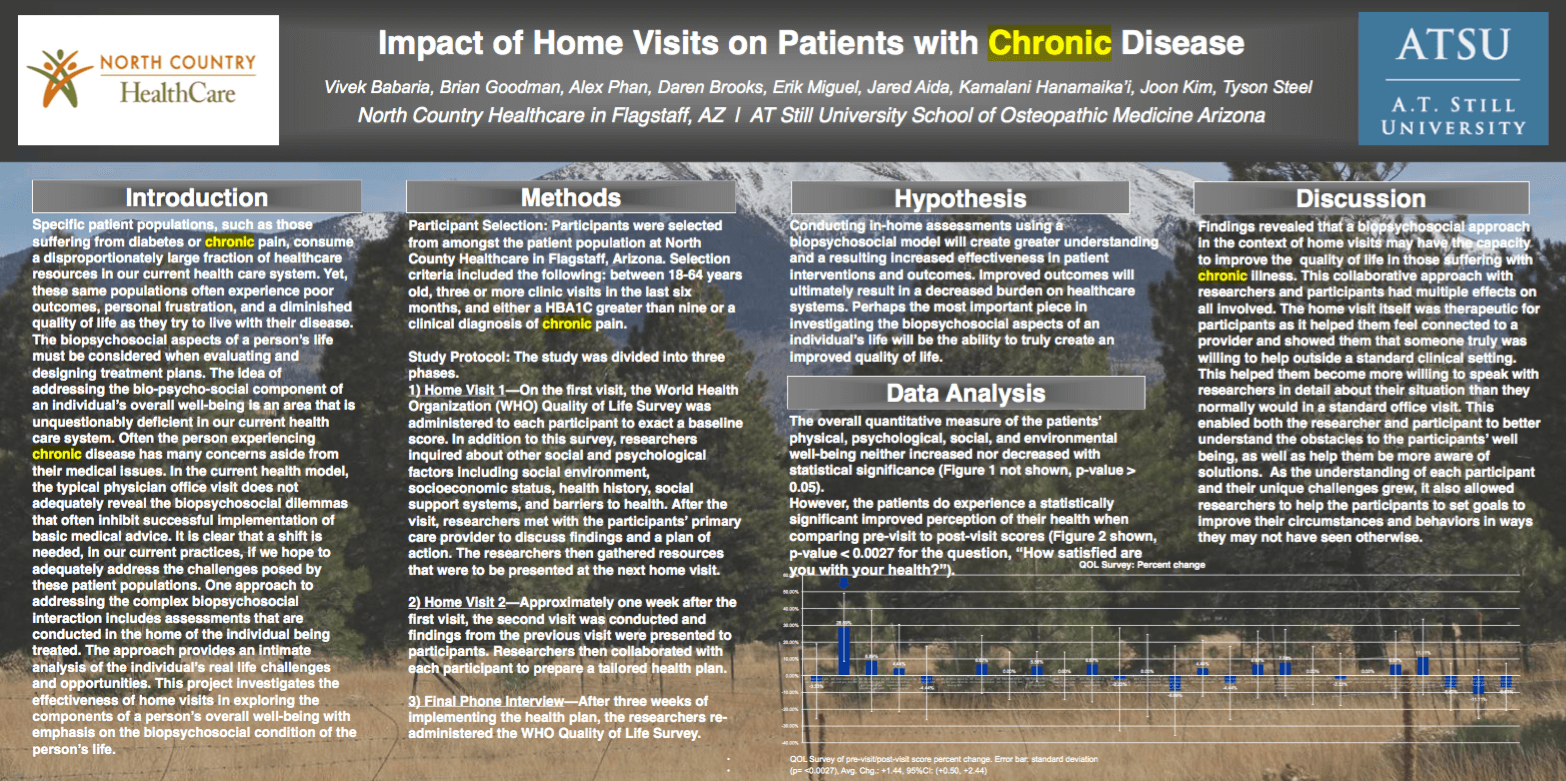Prescription Medication Regimines for Chronic Disease in Troy, Alabama
An Evaluation of Patient Comprehension
In partnership with the National Association of Community Health Centers, SOMA uses innovative models to prepare service-minded students to meet the health care needs of society by placing them in medically underserved areas for their training. This unique approach is available nowhere else in the country.
Students spend the first year in didactic learning settings, then the next three years gaining hands-on experience with patients at one of several Community Campuses around the nation. This enables the SOMA student to help provide affordable, quality healthcare to patients in need while receiving intensive training in osteopathic medicine.
Research Objectives
Polypharmacy and medication non-compliance are known obstacles to patient care. We became interested in investigating this barrier while rotating in Troy, AL. Research objectives are:
- Quantifying how well patients manage polypharmacy
- Ascertaining relationships between demographic factors and medication self- efficacy
- Iidentifying who provides patients with the best prescription medication information.
Study Design and Methods
Surveys (Survey 1) were distributed in-person by the students during January and February of 2013 to customers at 1 chain pharmacy and 2 community pharmacies. The survey contained 7 questions from the Medication and Use Self-Efficacy Scale (MUSE), 4 demographic questions, and 3 questions on number of all prescriptions and chronic prescriptions, and who is their primary medication education provider. The non- parametric data collected was analyzed using Kolmogrov-Smirnov, Kruskal-Wallis, Mann-Whitney U and Spearman’s rho tests. A separate 15-question survey (Survey 2) was completed by pharmacy staff at the 3 locations with questions on their attitudes and knowledge of medication therapy management (MTM). Principle Findings and Quantitative/Qualitative Results
Survey 1 was completed by voluntary participants (n = 180). Gender, age, education, and ethnicity were compared to MUSE scores of all participants. No significant correlations were found. When subjects reporting 0 chronic prescription medications (n=30) were excluded from analysis, a significant correlation was found. Age vs. overall MUSE score yielded a weak positive correlation (rs = -0.151, sig. 0.043) using a Spearman’s rho test. Analysis showed 48% (n = 117) of patients received the most helpful information about their medications from the doctor, nurse or P.A., 29% (n = 71) from the pharmacist, and 7% (n = 17) from pamphlets.
Limitations
This study had several limitations. First, of the 399 individuals observed, only 180 consented to be surveyed. Second, the responses to the MUSE scale questions were extremely skewed to the positive - with 92.8% of survey responses recorded in the affirmative. This may be due to social desirability response bias that was created by the presence of the surveyor during the data collection. Additionally a recall bias may have been contributed to this skew. Third, volunteer sample bias summoned only volunteered responses which may have differed from those who declined to take the survey. Many of those declined due to visual impairment or other handicap, which led to surveyors reading the questions to the patient. This may have led to responses which were biased on the behalf of the surveyor. Fourth, due to the categorical/dichotomous data which was being collected, a larger sample population was needed. The pool of survey subjects became exhausted as the survey sessions continued and repeat pharmacy customers were more frequently seen. Finally, these surveys were distributed in small, community pharmacies, therefore the results may not be generalizable to other larger medical settings such as ambulatory, primary, or emergency care.
Conclusion and Impact on Health Centers
Surveys (Survey 1) were distributed in-person by the students during January and February of 2013 to customers at 1 chain pharmacy and 2 community pharmacies. The survey contained 7 questions from the Medication and Use Self-Efficacy Scale (MUSE), 4 demographic questions, and 3 questions on number of all prescriptions and chronic prescriptions, and who is their primary medication education provider. The non- parametric data collected was analyzed using Kolmogrov-Smirnov, Kruskal-Wallis, Mann-Whitney U and Spearman’s rho tests. A separate 15-question survey (Survey 2) was completed by pharmacy staff at the 3 locations with questions on their attitudes and knowledge of medication therapy management (MTM). Principle Findings and Quantitative/Qualitative Results
Survey 1 was completed by voluntary participants (n = 180). Gender, age, education, and ethnicity were compared to MUSE scores of all participants. No significant correlations were found. When subjects reporting 0 chronic prescription medications (n=30) were excluded from analysis, a significant correlation was found. Age vs. overall MUSE score yielded a weak positive correlation (rs = -0.151, sig. 0.043) using a Spearman’s rho test. Analysis showed 48% (n = 117) of patients received the most helpful information about their medications from the doctor, nurse or P.A., 29% (n = 71) from the pharmacist, and 7% (n = 17) from pamphlets.
